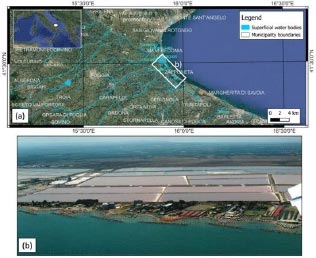Abstract
Low-lying coastal zones are highly subject to coastal hazards as a result of sea-level rise enhanced by natural or anthropogenic land subsidence. A combined analysis using sea-level data and remote sensing techniques allows the estimation of the current rates of land subsidence and shoreline retreat, supporting the development of quantified relative sea-level projections and flood maps, which are appropriate for specific areas. This study focuses on the coastal plain of Tavoliere delle Puglie (Apulia, Southern Italy), facing the Adriatic Sea. In this area, land subsidence is mainly caused by long-term tectonic movements and sediment compaction driven by high anthropogenic pressure, such as groundwater exploitation and constructions of buildings. To assess the expected effects of relative sea-level rise for the next decades, we considered the following multidisciplinary source data: (i) sea-level-rise projections for different climatic scenarios, as reported in the Sixth Assessment Report of the Intergovernmental Panel on Climate Change, (ii) coastal topography from airborne and terrestrial LiDAR data, (iii) Vertical Land Movement (VLM) from the analysis of InSAR and GNSS data, and (iv) shoreline changes obtained from the analysis of orthophotos, historic maps, and satellite images. To assess the expected evolution of the coastal belt, the topographic data were corrected for VLM values, assuming that the rates of land subsidence will remain constant up to 2150. The sea-level-rise projections and expected flooded areas were estimated for the Shared Socioeconomic Pathways SSP1-2.6 and SSP5-8.5, corresponding to low and high greenhouse-gas concentrations, respectively. From our analysis, we estimate that in 2050, 2100, and 2150, up to 50.5 km2, 118.7 km2 and 147.7 km2 of the coast could be submerged, respectively, while beaches could retreat at rates of up to 5.8 m/yr. In this area, sea-level rise will be accelerated by natural and anthropogenic land subsidence at rates of up to −7.5 ± 1.7 mm/yr. Local infrastructure and residential areas are thus highly exposed to an increasing risk of severe inundation by storm surges and sea-level rise in the next decades.
Figure

The coastal plain of Tavoliere delle Puglie: (a) geographic map of the coastal plain; (b) aerial photograph of the salt marshes located in the Zapponeta area with defenses built along the coast.
How to cite and download the publication:
Scardino, G.; Anzidei, M.; Petio, P.; Serpelloni, E.; De Santis, V.; Rizzo, A.; Liso, S.I.; Zingaro, M.; Capolongo, D.; Vecchio, A.; et al. The Impact of Future Sea-Level Rise on Low-Lying Subsiding Coasts: A Case Study of Tavoliere Delle Puglie (Southern Italy). Remote Sens. 2022, 14, 4936. https://doi.org/10.3390/rs14194936